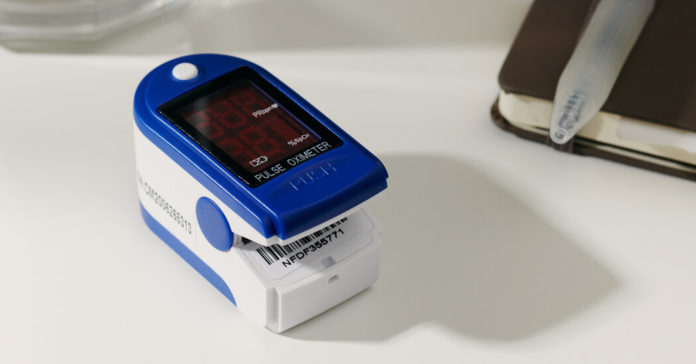When my daughter returned to school this fall, I sent a care package that was perfect for a college student living through a pandemic. It included cookies, a coffee mug — and a pulse oximeter.
A pulse oximeter is a small device that clips on your finger and measures your blood oxygen levels. Even though my daughter and her friends are all vaccinated against Covid-19, I wanted her to have the device handy just in case she got a breakthrough infection.
Many people first learned about a pulse oximeter in the early days of the pandemic, after doctors warned that some patients with Covid-19 develop a form of oxygen deprivation called “silent hypoxia,” which occurs when blood oxygen levels drop so slowly that a patient doesn’t notice anything is wrong. Often these patients are so ill by the time they get to the hospital that they need to be put on a ventilator.
New research from South Africa shows that using a pulse oximeter to check oxygen levels after a Covid diagnosis really does save lives. For the study, 8,115 high-risk patients were given a pulse oximeter to use at home after Covid-19 was diagnosed. The study focused on the highest-risk patients, including older people, those who were pregnant or those with chronic illnesses like heart disease, hypertension or diabetes.
After a Covid diagnosis, the patients were given a pulse oximeter and received a follow-up call to make sure they were using it correctly. They were asked to record their oxygen saturation and heart rate twice a day, and instructed to call a doctor if the reading started to drop below 95 percent.
If the reading fell below 90 percent, they were instructed to go to the emergency room. And all the patients were told to seek emergency care if they had difficulty breathing, regardless of the number on the device.
The study group was then compared with about 30,000 patients in the general population who were seen by doctors across the country between March and October of 2020. During the study period, 544 people (out of 38,660 patients) died from Covid-19, including 49 in the study group.
But the risk of dying was 52 percent lower among the patients who had been instructed to monitor their oxygen at home. Based on the overall mortality rate, it was expected that 95 people in the study group would have died. But using a pulse oximeter appears to have saved the lives of 46 people.
“I think it’s important to know that a pulse oximeter makes a difference,” said Shirley Collie, an author of the new study and chief health analytics actuary at Discovery Health, a large managed care administrator in South Africa. “You’re monitoring your oxygen because the timing of when you get to the hospital makes a huge difference on your clinical outcome.”
The magnitude of the benefit startled even some of the staunchest supporters of home oxygen monitoring. Dr. Richard Levitan, an emergency room doctor who sounded the alarm about silent hypoxia in a guest essay for The Times, called the findings “astounding.”
“It’s exceedingly rare in medicine to show such a huge difference in treatment, particularly with such a complicated disease,” said Dr. Levitan, who practices at Littleton Regional Healthcare in New Hampshire. “All of this happened with different management, in different hospitals, while the pandemic was unfolding. To have a 50 percent mortality difference is phenomenal. We almost never see a benefit as large as that.”
The researchers said the difference in mortality between the two groups appeared to be explained by the fact that people monitoring their oxygen levels at home sought medical care sooner in the course of their illness. Among the patients who went to the hospital, those who had used a pulse oximeter at home had lower levels of inflammation, as measured by a C-reactive protein (CRP) test.
In addition to helping patients know when to seek medical care, a pulse oximeter can lower anxiety after a Covid-19 diagnosis. Ms. Collie said she experienced the benefit firsthand after experiencing a breakthrough infection this summer, despite being fully vaccinated with the Johnson & Johnson vaccine. She had a cough and tightness in her chest and regularly monitored her oxygen levels at home. “It does give a lot of comfort in terms of checking where you’re at,” she said. “This monitoring can modify your risk of a really bad outcome. I think it’s hugely empowering.”
To use a pulse oximeter, press the device open as you would press a clip or clothespin, and place your finger snugly inside. The device beams different wavelengths of light through your finger. It’s targeting hemoglobin, a protein molecule in your blood that carries oxygen. Your pulse oximeter will give you a numerical reading — a percentage that indicates the level of oxygen saturation in your blood. Within seconds, it lights up with numbers indicating your blood oxygen level and heart rate.
Most healthy people will get an oxygen reading around 95 to 99 percent. Some people with existing health conditions may have a lower normal reading. In general, doctors say you should seek medical advice if the number drops rapidly or falls below 94.
But the accuracy of the device can vary, particularly in patients with dark skin. One study found that the result wasn’t accurate in one in 10 Black patients. A person with dark skin can still use the device, but doctors say it’s important to pay attention to any downward trend in oxygen readings, rather than fixating on a particular number. If you’re sick at home with Covid-19 and your normal reading drops by four points or more, that’s a good reason to call your doctor.
The South Africa study was conducted before vaccines were available, and vaccinated people have a far lower risk of serious illness or being hospitalized for Covid-19. But some vaccinated people, particularly those in high-risk groups, can still develop severe illness. Dr. Levitan said that even if you are vaccinated and at low risk of serious illness, you should use a pulse oximeter after a Covid-19 diagnosis.
“Your odds of getting seriously ill are low, but I’ve hospitalized patients with Covid pneumonia who are vaccinated,” Dr. Levitan said. “Across all of medicine, with earlier treatment people do better. If you come in early and spend three to five days in the hospital, that’s very different than coming in late and landing in the I.C.U.”
Source : Nytimes














